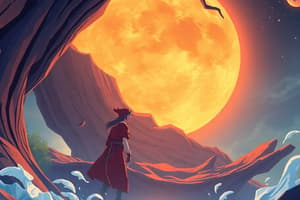Podcast
Questions and Answers
What is traditional animation?
What is traditional animation?
Traditional animation is an animation technique where each frame is drawn by hand.
Which of the following is NOT a step in the traditional animation process?
Which of the following is NOT a step in the traditional animation process?
Match the steps of the traditional animation process with their descriptions:
Match the steps of the traditional animation process with their descriptions:
Storyboard = A collection of hand drawings displayed in sequence for previsualizing animation. Voice Recording = Recording sounds and speech used in the animated film. Animatic = A videotaped version of the storyboard matched with recorded voices. Backgrounds = Creating a set design for specific scenes in the animated film.
The _____ is where animators begin drawing sequences of animation.
The _____ is where animators begin drawing sequences of animation.
Signup and view all the answers
The layout process in traditional animation includes determining the camera angles and lighting.
The layout process in traditional animation includes determining the camera angles and lighting.
Signup and view all the answers
What is a storyboard?
What is a storyboard?
Signup and view all the answers
Study Notes
Traditional Animation Process
- Traditional animation involves hand-drawing each frame, known as classical animation or cel animation.
- It was the primary animation method in cinema before computer animation emerged.
Key Steps in 2D Animation
- A complex and time-consuming process.
- Main steps include: storyboard, voice recording, animatic, designing and timing, layout, animation, pencil test, backgrounds, filming, and post-production.
Storyboard
- A sequence of hand-drawn images that visualize the animation sequence.
- Functions as a script that aids in planning plot flow and imagery composition.
- Regular meetings with the director may require artists to revise frequently until final approval.
Voice Recording
- Sounds and speech are recorded prior to animation, establishing audio for the film.
- This can occur post-animation to synchronize speech with animated actions.
Animatic
- A video version of the storyboard created post-soundtrack, often referred to as a story reel.
- Serves to align recorded voices with the storyboard elements before full animation.
Design
- Character designers produce model sheets showing characters and props from various angles and poses.
- Model sheets ensure consistency among all artists involved in the project.
Layout
- Conducted after design approval, focusing on camera angles, paths, lighting, and shading.
- Similar to blocking shots in live-action filmmaking, executed by background layout artists.
Animation
- Animators draw sequences on transparent paper, typically with colored pencils, capturing one frame at a time.
- Each drawn frame is placed sequentially to create the animation flow.
Pencil Test
- Completed drawings are photographed on an animation camera or through current video and computer tools.
- This step allows animators to review the animation's fluidity and timing.
Backgrounds
- Creation of set designs for specific scenes to establish the environment where characters and objects move.
- Backgrounds enhance the visual context in which the animated action occurs.
Filming
- Involves photographing painted images on clear acetate sheets to create composite shots.
- Layers of these sheets are arranged under a camera to form the animated film sequence.
Post-Production
- Final phase focuses on polishing the animation, combining audio recordings and film.
- Ensures that the final animated film is ready for distribution, improving sound quality and visual presentation.
Studying That Suits You
Use AI to generate personalized quizzes and flashcards to suit your learning preferences.
Related Documents
Description
This quiz covers the fundamentals of the traditional animation process as part of Animation 2. Students will demonstrate their understanding by discussing key concepts and techniques involved in classic animation methods. Prepare to explore the fascinating world of animation!




